If you are wondering which are the best national parks in California, most people will say Yosemite National Park tops the list. However, from north to south, the state has much to offer in addition to the country’s most famous national park.
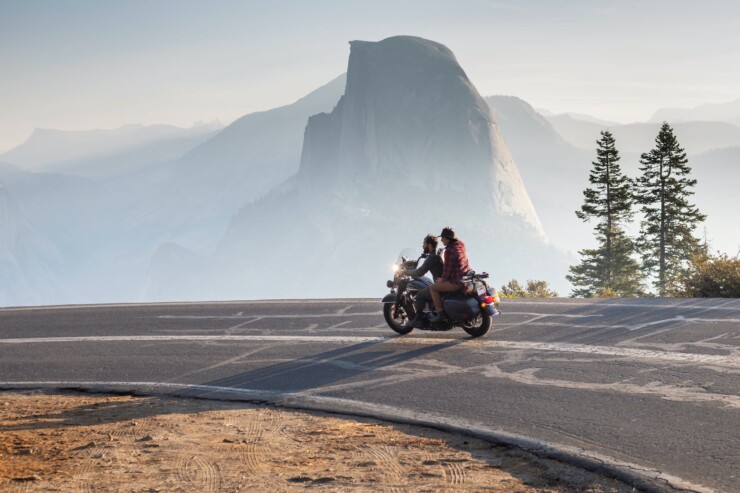
Key Takeaways
- California is home to nine national parks—more than any other U.S. state—and each offers a unique landscape, from deserts and granite peaks to rugged coastline and volcanic terrain.
- Here we're sharing which national park to visit based on your interests, whether you're into stargazing, beach walks, alpine hikes, or wildflower spotting.
- We're sharing insider travel tips, including when to visit each park, must-see highlights, and ideas for nearby food and wine experiences.
The best national parks in California represent the Golden State at its finest. We’re talking ancient coastal forests and rugged mountains, lava beds and otherworldly deserts. These national parks in California offer a wealth of hiking, sightseeing, and adventure opportunities.
I was born and raised in California and grew up hiking, camping, and skiing in its great outdoors. These days, I live in Mammoth Lakes, just under an hour from the entrance to Yosemite National Park. Between my free time and my time researching for our travel clients, I spend a lot of time at the national parks in California.
As a travel company specializing in California travel planning, we help many food lovers bound for California craft the ultimate road trip itinerary. And, whenever possible, we always aim to include one of the national parks in California in their trip.
While our cities are filled with world-class food and culture, I believe they’re best contrasted by the immense wilderness areas and spectacular views that the national parks in California provide.
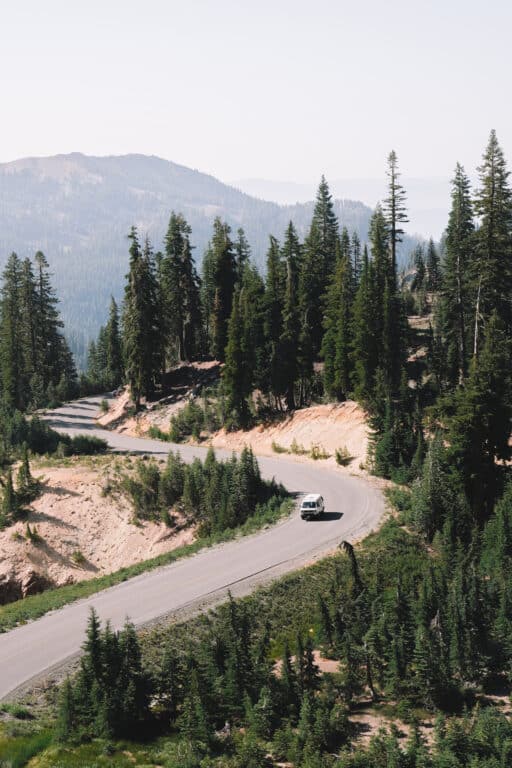
The 9 Best National Parks in California
Here we’re sharing what you need to know about the nine national parks in California, as well as a few not-to-be-missed national monuments and landmarks. Let’s start from California’s northernmost corners and work our way south.
And, before we get started, here are the nine national parks in California listed from north to south:
- Redwood National and State Parks
- Lassen Volcanic National Park
- Yosemite National Park
- Sequoia National Park
- Kings Canyon National Park
- Pinnacles National Park
- Death Valley National Park
- Joshua Tree National Park
- Channel Islands National Park
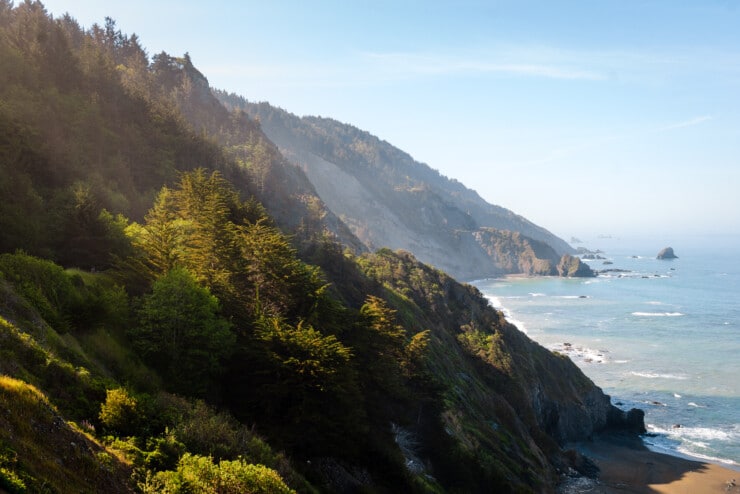
Northern California National Parks
Redwood National and State Parks
Redwood National and State Parks cover more than 100,000 acres along California’s northernmost coast. It’s one of the most unique national parks in California for two reasons. First, it’s a string of four parks — including Redwood National Park, Jedediah Smith Redwoods State Park, Del Norte Coast Redwoods State Park, and Prairie Creek Redwoods State Park.
Second, it’s one of the only places in California to see redwoods. That’s because 96 percent of the state’s redwood forests were felled by the timber industry beginning in the 1850s. Combined, these parks contain about 45% of the world’s protected ancient coast redwood forests, so they’re a major treasure.
What To Do: Today, you can venture through the world’s tallest trees on trails like the easy Lady Bird Johnson Grove loop or the Fern Canyon Loop Trail, new as of 2022. We also adore its other natural features, such as the Klamath River, coastline, beaches, and open prairies. The National Park Service and California State Parks partner with the Yurok and Tolowa people to preserve and restore sensitive habitats, protect archaeological sites, and safeguard wildlife.
Where To Stay: If you’re not camping or staying in basic cabins in the park, then you’ll likely stay in inns, bed and breakfasts, and rental cottages nearby, like Gingerbread Mansion Inn.
Places to eat around Redwood National and State Parks include casual spots off Highway 101, such as The Lighthouse Grill and Larrupin Cafe in Trinidad. Most visitors headed to Redwood National and State Parks do so as part of a California road trip on Highway 325 north of San Francisco.
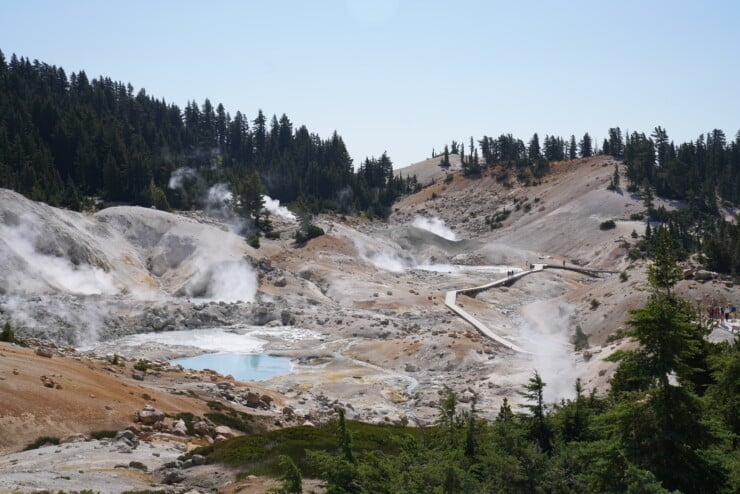
Lassen Volcanic National Park
One of the least visited national parks in California is also one of the most scenic and unique and therefore one of the best to visit to escape the crowds. Lassen Volcanic National Park boasts all four types of Earth’s volcanoes and 150 miles of trails including the hike to Lassen Peak, the world’s largest plug-dome volcano. It’s like Yellowstone meets Yosemite but with decidedly more elbow room. Find this park about 50 miles east of Redding, California.
What To Do: Drive along Highway 89 to pass by Lassen Peak as well as geothermal formations, and stunning picnic areas. While experienced hikers can challenge themselves to climb the Lassen Peak Trail, the Bumpass Hell hike is moderate and rewarding as it leads to an active geothermal areas.
Where To Stay: The recently-constructed Manzanita Lake Camping Cabins are a good value for families or groups. Otherwise, head to Drakesbad Guest Ranch for horseback riding and hot-springs. Note that the park is hard to access in the winter months so we’d suggest visiting spring through fall.
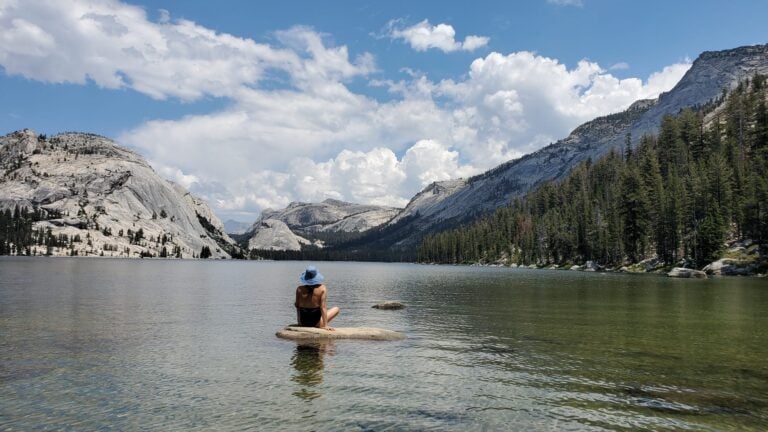
Central California National Parks
Yosemite National Park
As the second-oldest national park with more than three million visitors annually, Yosemite National Park is one of the most famous and iconic national parks in the country. (Technically, it’s the third national park after Mackinac National Park in Michigan, which was named a National Park but then turned over to the State in 1895.)
Yosemite is widely considered one of the best and most beautiful parks in California. The Miwok people of the southern Sierra Nevada originally called this area home.
What to Do: This sprawling corner of the Sierra Nevada is loved for its natural beauty. There are waterfalls like Yosemite Falls—the tallest waterfall in North America —and impressive granite domes and walls, such as Half Dome and El Capitan. Lookouts like Glacier Point, along with alpine lakes and meadows, create picturesque hiking scenery.
Some popular stops include snapping a postcard-perfect photo at Tunnel View (also known as Wawona Tunnel), hiking the Mist Trail to Vernal Falls, and venturing up Half Dome.
FYI, the Half Dome hike clocks in at more than 14 miles and 5,000 feet elevation round-trip. This day hike requires a reservation by lottery; however, many reservation-free hikes are shorter and easier, such as Sentinel Dome or Taft Point.
The summer months bring tubing to Sentinel Beach, while winter brings skiing at Badger Pass Ski Resort, as well as the “fire falls,” which occur when Horsetail Falls glow orange at sunset.
Where to Stay: We have a comprehensive article on where to stay near Yosemite National Park for your reference.
In short, the in-park accommodation options are limited to a few lodges and some tented cabins, so most visitors stay outside the park. The main towns are Oakhurst, Mariposa, and Groveland. Some of the best lodging options near the park include glamping at AutoCamp Yosemite, Rush Creek Lodge & Spa, and Evergreen Lodge. There are multiple ways to reach Yosemite National Park, and the park’s website provides the most comprehensive directions.
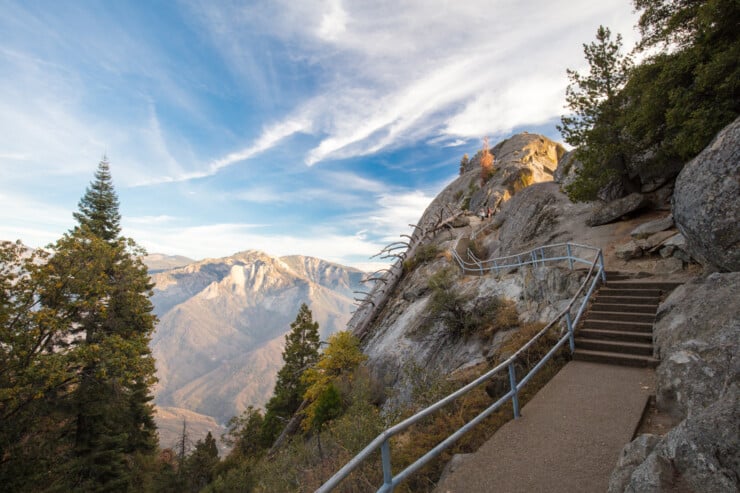
Sequoia & Kings Canyon National Park
Another place to see huge, tall trees in California is central California’s Sierra Nevada mountains and the original homelands of the Mono (Monache) and Paiute, among other indigenous groups.
Here, giant sequoias are the main draw to Sequoia & Kings Canyon National Park, including the legendary General Sherman Tree. They were originally two separate parks until the 1940s, when they were combined, and the scenic Generals Highway now connects them.
Side note: Sequoias differ from redwood trees! Redwoods are the world’s tallest trees, while sequoias are the world’s largest trees by volume. Redwoods also grow on the coast, and sequoias grow inland at elevation.
What To Do: Check out sequoia groves by car or on a trail for hikers of all levels, like the ones that pass through meadows and other tall trees and viewpoints in Giant Forest & Lodgepole, and Cedar Grove‘s granite walls, rivers, and waterfalls.
Visitors also enjoy horseback riding, rock climbing, kayaking (for experts only), and skiing and snowshoeing in the winter.
Where to Stay: There are four lodges and inns within the park, including Wuksachi Lodge, located at an elevation of 7,200 feet. It features several restaurants and cafes, as well as easy access to hiking and cross-country ski trails.
Outside the park to the west, the small town of Three Rivers offers more hotels and dining options, although you can also venture to larger cities like Visalia.
In Three Rivers, Sequoia Coffee Co. serves caffeine and breakfast, while Casa Mendoza specializes in Mexican food. Additionally, the city of Fresno is approximately an hour’s drive from the park and offers farmers’ markets, as well as various options for locally sourced food.
To get here, you’ll either enter from the west via Fresno (Highway 180 to Kings Canyon) or Visalia (Highway 198 to Sequoia National Park). Please note that the park is difficult to access during the winter months, so we recommend visiting from spring through fall.

Pinnacles National Park, Central California
Pinnacles National Park achieved national park status in 2013, making it one of the newer national parks in California. It’s known for finger-like rock formations shaped by ancient volcanic eruptions and erosion, and as a home to the endangered California condor.
It’s located approximately 50 miles east of Monterey, off Highway 101, and offers hiking trails, year-round camping, and more.
What To Do: This is a premier destination for rock climbing in California, so it’s a great place to try your hand at the sport. Additionally, this national park in California is renowned for its two talus caves, the Balconies, and Bear Gulch Cave. The park’s beauty is best enjoyed via hiking, so plan to ascend the peaks for a scenic view.
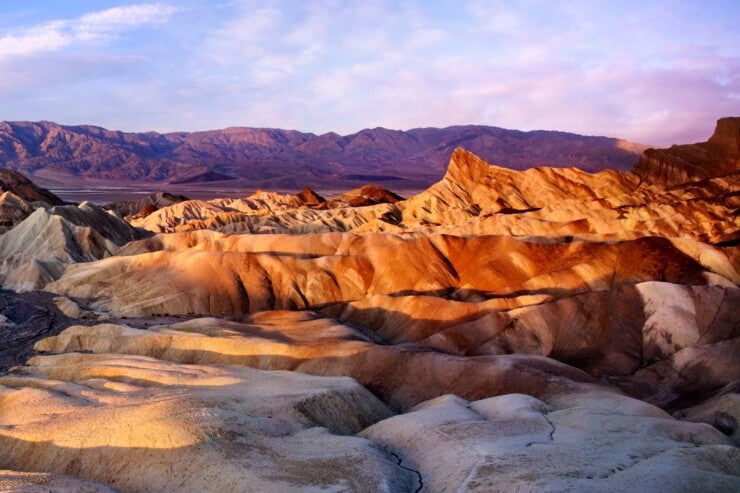
Southern California National Parks
Death Valley National Park
Summer temperatures may top 120 degrees, but that doesn’t stop more than one million annual visitors to Death Valley National Park. Another pick as one of the best national parks in California, this park is the largest national park in the contiguous United States.
Set between California’s Sierra Nevada mountains and the Nevada state line, it earned its name in 1849 when a group of gold rushers on their way West in horse-drawn wagons nearly died in the valley (one did.) Before all of that, indigenous Timbusha Shoshone people had long migrated between the area’s valleys and mountains.
What to Do: In cooler months, hiking through its canyons and sand dunes is a popular activity, as is taking in the unique sights from the multi-colored Artists Palette and Zabriskie Point. Dante’s View overlooks the basin and is considered one of the best spots in the park.
But, of course, it’s best known for Badwater Basin, which is the lowest point in North America at 282 feet below sea level. Many visitors like to visit Badwater Basin and then embark on the 84-mile journey to the northwest to Mount Whitney, the highest point in the contiguous United States.
Where to Stay: Within Death Valley National Park, there are campgrounds, four inns, and resorts. Some, like The Oasis at Death Valley, even have an outdoor spring-fed swimming pool. It has two properties— Inn at Death Valley and The Ranch at Death Valley.
Outside of the park, there are inns and hotels on the Nevada side in small towns like Pahrump and Beatty, as well as on the California side in Lone Pine. Aside from the eats in and immediately around the Park, it’s possible to eat at any of the places we enjoy along California Highway 395.
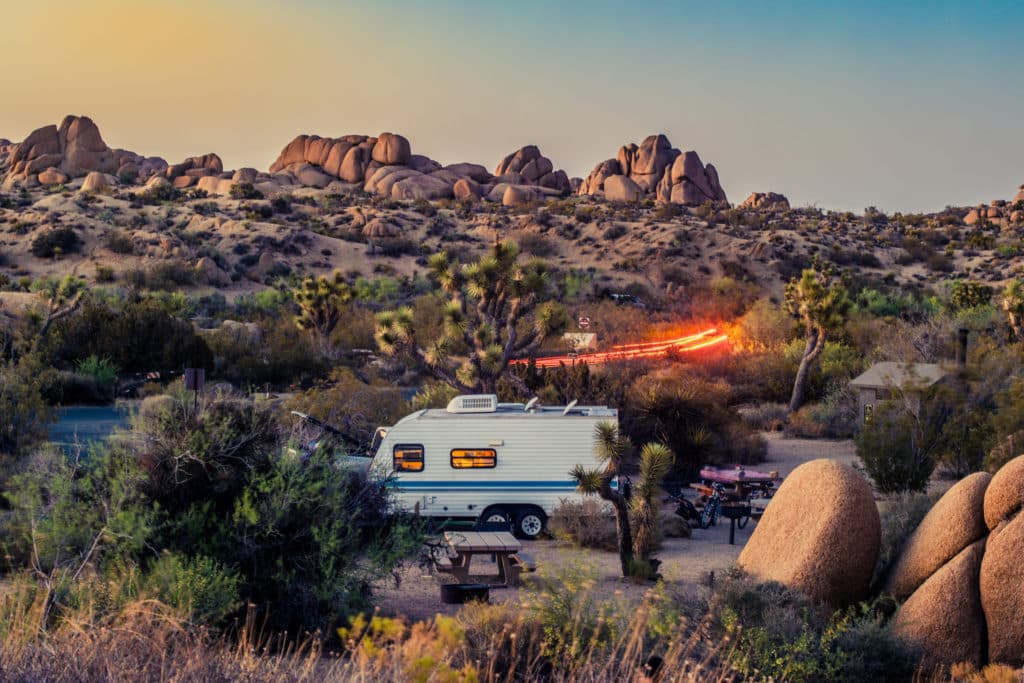
Joshua Tree National Park
Chances are you’ve heard of Joshua Tree National Park’s whimsical Joshua trees, interesting rock formations, and overall classic Mojave and Colorado desert scenery. (Btw, Joshua trees grow only in the Mojave Desert.) Or maybe you’re heading there to stargaze, cycle, or get your hike on at one of the most beloved national parks in California.
What To Do: That said, a one-mile hike to Barker Dam for a chance to spot Bighorn sheep and pics at Skull Rock are some can’t-miss activities. As the Park’s highest viewpoint, Keys View overlooks Coachella Valley, the San Andreas Fault, and maybe Mexico on a clear day. The Park is also popular with rock climbers.
Where To Stay: Most visitors opt for camping in the park or renting an Airbnb in nearby Pioneertown or Twentynine Palms. However, Palm Springs and the surrounding Coachella Valley cities are just a one-hour drive away, offering a range of options from luxury resorts to mid-century modern boutique properties.
As for dining, local spots near the park, such as Crossroads Cafe, offer breakfast, lunch, and dinner options. Although Palm Springs does have an airport that’s about 45 miles from the Park, you’ll likely arrive by car if you’re road-tripping through Los Angeles, Orange County, or San Diego.

Channel Islands National Park, Southern California
These five islands off the southern California coast are also known as the “Galapagos of North America,” as their only permanent inhabitants are endemic plants and wildlife, such as seals and the island fox.
Adventurers embark on a 20-mile boat ride to Channel Islands National Park, comprising Anacapa Island, Santa Cruz Island, San Miguel Island, Santa Barbara Island, and Santa Rosa Island. The Channel Islands are more rugged than California’s other islands, such as Catalina or Coronado Island, which is why we adore them as one of the best national parks in California.
What To Do: These islands are nicknamed “California’s Galapagos” thanks to their incredible diversity of animal species and plant life. Head here to hike, kayak, and scuba dive among tide pools and kelp forests.
Where to Stay: Many visitors use an outfitter based in Ventura, Oxnard, or Santa Barbara to head out for a day or overnight trip.
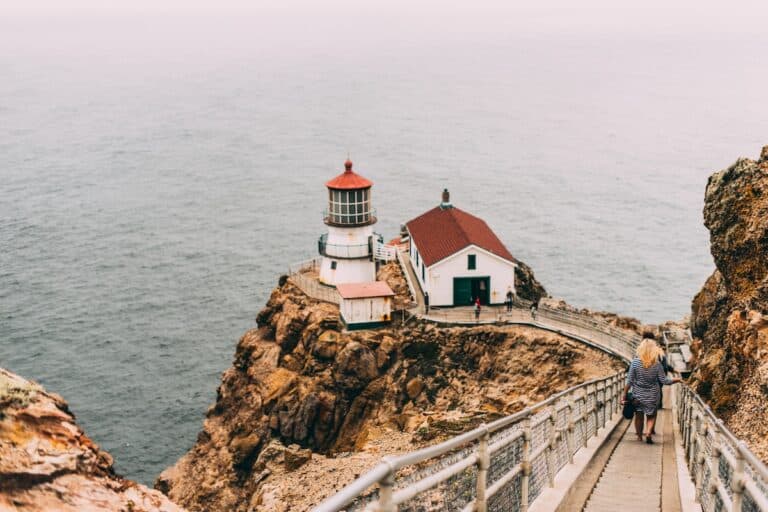
National Landmarks and National Monuments to Know
There is a ton to explore at the national parks in California, so you’ll keep plenty busy when you visit. But, don’t forget these three national landmarks across the state that are also worth visiting:
Alcatraz Island
What was once a maximum-security federal prison is now a well-known National Historic Landmark, situated near the Golden Gate Bridge. Alcatraz Island is a 15-minute ferry ride from San Francisco, where you can take a guided or self-guided tour.
Point Reyes National Seashore
Wild stretches of coastline in California are a thing of the past, except for protected areas like Point Reyes National Seashore. Less than 40 miles north of San Francisco, the Seashore offers nearly 80 miles of sandy beaches and trails with views of the Pacific Ocean. It’s popular during the gray whale migration season between December and mid-March.
Devils Postpile National Monument
Considered a rare geologic site, Devil’s Postpile National Monument, near the Eastern Sierra town of Mammoth Lakes, is worth visiting when it’s open in late spring to early fall. Admire the towering basaltic columns at ground level or hike to the top of the postpile. Please note that most visitors traveling by car will need to take the shuttle bus from Mammoth Mountain Ski Area.
Frequently Asked Questions About National Parks In California
California is home to nine national parks, each known for its unique natural features. Yosemite National Park is famed for its towering granite cliffs and waterfalls. Sequoia and Kings Canyon National Parks are renowned for their giant sequoia trees. Death Valley National Park is known for its extreme desert landscapes.
Joshua Tree National Park is famous for its Joshua trees and rock formations. Redwood National Park houses the tallest trees in the world. Lassen Volcanic National Park offers geothermal features like fumaroles and hot springs. Channel Islands National Park consists of five islands with unique ecosystems. Pinnacles National Park is known for its rock formations and talus caves.
The best time to visit California's national parks varies by location due to the diverse climates across the state. Spring (April to June) is ideal for Yosemite, Sequoia, and Kings Canyon due to the mild weather and blooming wildflowers. Fall (September to November) is perfect for Death Valley and Joshua Tree when temperatures are cooler.
Summer (June to August) is great for coastal parks like Channel Islands and Redwood, offering escape from the inland heat. Lassen Volcanic and Pinnacles are best visited in late spring through early fall to avoid snow. Always check individual park websites for seasonal closures and conditions before planning your visit.
When visiting California's national parks, it's important to plan ahead by checking park websites for current conditions, closures, and any required permits or reservations. Pack appropriately for the weather, which can vary greatly even within a single day. Always stay on designated trails to protect the natural environment and wildlife. Bring plenty of water, especially in desert parks like Death Valley. Lastly, consider visiting less crowded parks or during off-peak times to enjoy a more serene experience.
Get A Personalized Travel Itinerary

California-Inspired Recipes
Are you not yet headed out to explore these national parks in California, but still want to get a taste of the Golden State at home? Cook up these recipes inspired by the Golden State:
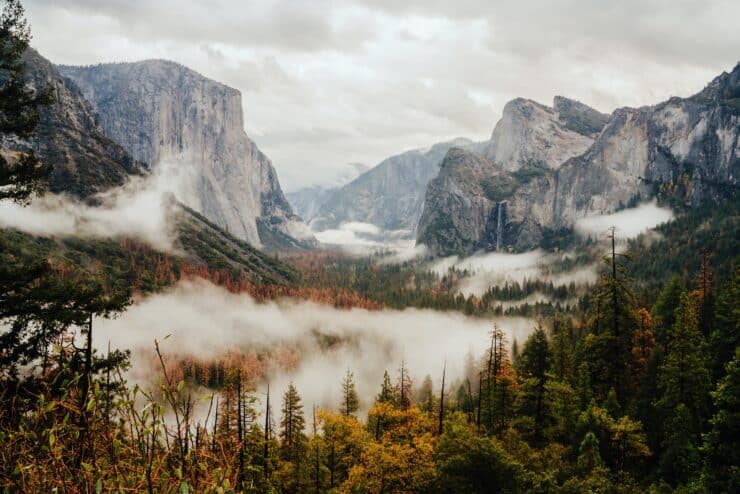
Where To Stay Near Yosemite
Now that you’re versed on the national parks in California, discover where to stay near Yosemite National Park. Whether you’re seeking a romantic getaway, a family adventure, or a solo escape into the wilderness, our guide will help you find the perfect base camp, whether it’s in Yosemite Valley or just outside the park. Prepare for an unforgettable journey into the heart of the wild, where comfort meets nature in harmony.

California Road Trip Guide
Need more insight about doing a road trip in California? Whether you’re visiting the national parks in California or heading to wine country, you’ll want to check out our complete California Road Trip Travel Guide. It’s a collection of tips (and recipes) to make your Golden State exploration the best!
Have Us Plan Your California Trip
Hey! We’re also a boutique travel agency specializing in California vacation planning! If you’re looking to plan a trip to California, our California trip planner services are here to help you plan your perfect itinerary.
Photo Credit: Opening photo of motorcyclists near Yosemite Half Dome by Michael Carni; Zabriskie Point, Death Valley by Doug Lemke; Redwoods National Park coast view and Lassen Volcanic National Park by Zack Frank; Moro Rock photo by FiledIMAGE; Point Reyes lighthouse by Tõnu Tunnel